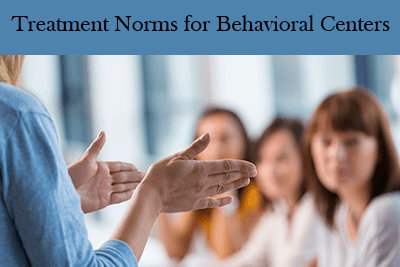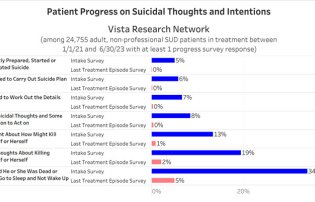To understand the areas in which your treatment center is excelling as well as opportunities for improvement, it is crucial to benchmark your performance against that of similar treatment centers. To make this easy to do, Vista regularly publishes the norms for centers in the Vista Research Network.
Between January 1, 2021 and June 30, 2023, Vista monitored the progress of 4,656 adults throughout their treatment at behavioral treatment centers. Each of these patients were also screened for substance use disorder and, if they were found to have at least a moderate SUD, were monitored for this also.
Additionally, Vista has followed up post-treatment with over 2,000 adult behavioral patients who were in treatment between July 1, 2016 and June 30, 2023. This includes 1,045 adult patients whom we attempted to contact at 12 months post-treatment.
Download Outcomes Norms
We will email you both the during-treatment norms and the post-treatment outcomes norms for adult behavioral patients if you click below:
Download Treatment Norms for Adult Behavioral Patients
During-Treatment Patient Monitoring Norms
The analyses included in the during-treatment norms files are:
Demographics:
- Gender/Age
- Living Arrangements
- Marital Status/Ethnicity
- Employment
- Education
- Patient's Location
Previous Treatment Episodes
Why Patients Entered Treatment
Key Life Goals
Mental Disorders at Intake:
- Overall Feeling
- Functioning (WHODAS 2.0)
- Depression Symptoms (PHQ-9)·
- Anxiety Symptoms (GAD-7)
- Trauma Symptoms (PCL-6)
- Mania Symptoms (Altman Self-Rating Mania Scale)
- Psychosis Symptoms (Yale's PRIME Screen Revised)
- Eating Disorders (Dr. Eric Stice's EDDS)
- Other Disorders
- Suicidal Thoughts (CSSRS)
- Self-Harming Behavior
Drug Use:
- Addiction Severity
- Primary Drug of Choice
Mental Disorder Improvement During Treatment:
- All Overall Feeling
- Functioning (WHODAS 2.0)
- Depression Symptoms (PHQ-9)
- Anxiety Symptoms (GAD-7)
- Trauma Symptoms (PCL-6)
- Mania Symptoms (Altman Self-Rating Mania Scale)
- Psychosis Symptoms (Yale's PRIME Screen Revised)
- Eating Disorders (Dr. Eric Stice's EDDS)
- Suicidal Thoughts (CSSRS)
Treatment Completion Rates:
- All Programs
- By Source of Payment
- By Program(s) Attended
Patient Satisfaction
Treatment Goals:
- Were patients asked about treatment goals
- Were treatment goals met
Behavioral Treatment Outcomes Norms
The following analyses are included in the post-treatment outcomes norms charts:
How Feeling Post-Treatment
- Overall Feeling at One Month Post-Treatment
- Overall Feeling at Six Months Post-Treatment
- Overall Feeling at Twelve Months Post-Treatment
- Overall Feeling Trends
Post-Treatment Abstinence (BH patients with Severe to Moderate SUD):
- 1M/6M/12M Post-Treatment Abstinence
- Abstinence Rate Trends
Factors Favoring Treatment Success:
- Overall Feeling at One Month Post-Treatment by Treatment Completion
- Overall Feeling at Six Month Post-Treatment by Treatment Completion
- Overall Feeling at Twelve Month Post-Treatment by Treatment Completion
- Twelve Month Post-Treatment Overall Feeling by Length of Stay
- Twelve Month Post-Treatment Overall Feeling by Addiction Severity
- Overall Feeling at Twelve Month Post-Treatment by After-Care Choices
- Abstinence at Twelve Months Post-Treatment by After-Care Choices (Severe to Moderate SUD)
Reduction in Severity of Mental Disorders:
- Depression Symptoms (PHQ-9)
- Anxiety Symptoms (GAD-7)
- Trauma Symptoms (PCL-6)
- Mania Symptoms (Altman Self-Rating Mania Scale)
- Psychosis Symptoms (Yales's PRIME Screen Revised)
- Functioning Symptoms (WHODAS 2.0)
Quality of Life: One Year Post-Treatment
- Overall Feeling
- Stable Housing
- Relationship with Closest Family Member
- Employment
- Criminal Justice Offenses
- Progress on Achieving Non-Usage Goals at 12M Post-Treatment (Overall Feeling)
- Expensive Medical Interventions
Patient Satisfaction


